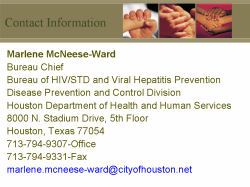Slide Set F: Program Integration: The Houston Experience
This website is archived for historical purposes and is no longer being maintained or updated.
Download the complete slide set:
- 11 Slides in Adobe PDF Format - [64KB]
- 11 Slides in PowerPoint PPT Format - [189KB]
- 11 Slides in Adobe Flash Format - (128KB)

While the content is in the public domain and no copyright restriction applies, we do ask that users preserve the slides in their current format and cite CDC as the source.

Slide 1
Program Collaboration & Service Integration - The Houston Experience
PDF File or PPT File

Slide 2
A Historical Look
PDF File or PPT File

Slide 3
Why Integration?
PDF File or PPT File

Slide 4
HDHHS Disease Prevention and Control Division
PDF File or PPT File

Slide 5
Five Functional Units
PDF File or PPT File

Slide 6
Integration Activities
PDF File or PPT File

Slide 7
Barriers-Internal and External
PDF File or PPT File

Slide 8
Wins
PDF File or PPT File

Slide 9
Recommendations for Programs
PDF File or PPT File

Slide 10
Recommendations for CDC
PDF File or PPT File
- Page last reviewed: March 5, 2014 (archived document)
- Content source:


 ShareCompartir
ShareCompartir



